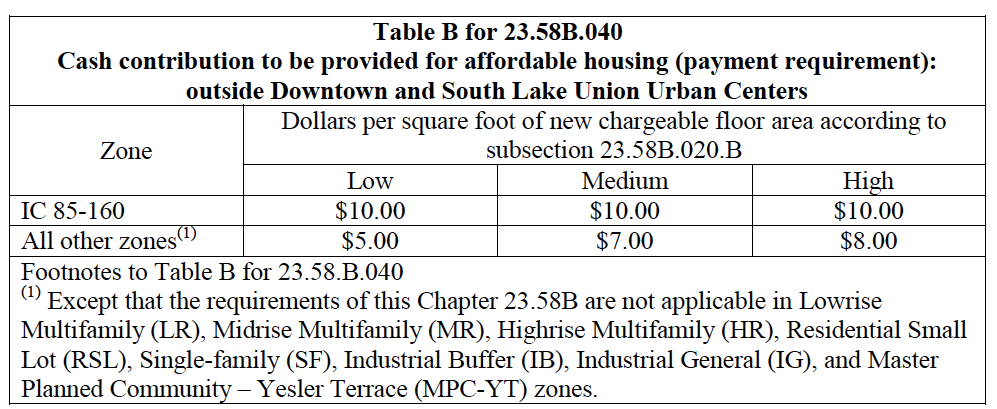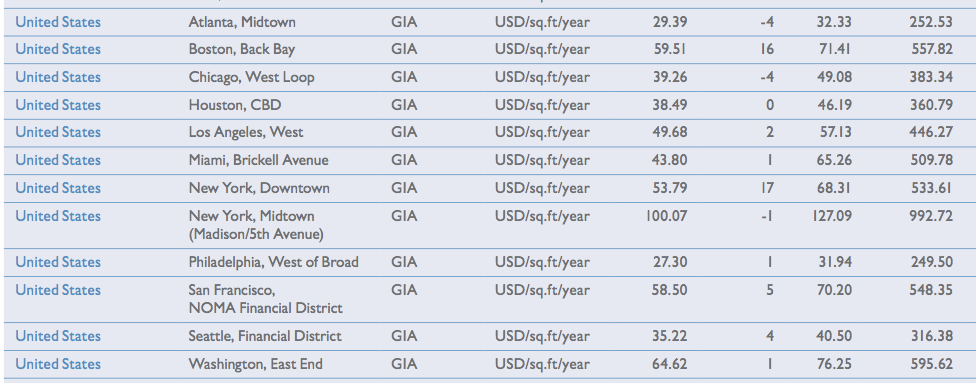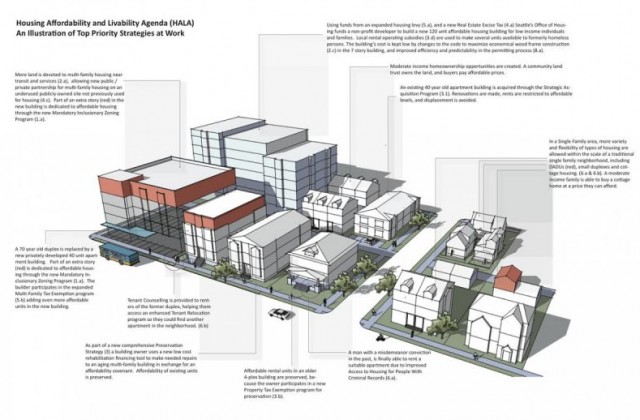Grand Bargain: This Isn’t Going to be Easy
I was on the Seattle Channel last week with Councilmember Mike O’Brien, Eastlake resident and micrhousing opponent Linda Alexander, and affordable housing developer and Grand Bargain signer Bill Rumpf. If you watch this whole show you’ll notice that the Grand Bargain is a lot more complicated than the group Seattle For Everyone (a group organized by Vulcan and non-profit housing developers to support the Grand Bargain) would have you believe. I keep trying to diagram the various interests in my mind that need to be held together to make the Bargain hold together. As I point out, the Grand Bargain is a political solution to avoid linkage taxes, not a real solution to housing issues. We’re finding the upzones simply don’t create value but actually make projects infeasible.
During the course of the 20 minute panel segment I referred directly to the Grand Bargain framework document (which you can read in full here: Final Framework_MIH and CLF_071315-1) to refute something that Councilmember O’Brien said about the extra floor that would be mandatory in new construction in low-rise zones. He said that the Council wouldn’t just be waving a wand and adding another floor but that in every neighborhood that value added for builders could be different; maybe some places there would be two floors and some other places no floors.
Aside from sounding like a complete nightmare–imagine trying to decide zoning increases block by block in negotiations with angry neighbors all across the city–the bargain doesn’t say that at all. I pointed out what the language, which I had right in front of me says:
2.b For low-midrise areas, this would add additional floor(s)/[Floor Area Ratio]FAR across most zones at or below 85′ (including LR, NC, C, MR).
And the document, signed by O’Brien, says that changes to capacity and more square footage would be “zone wide.” It’s also ironic that O’Brien indicated that the zoning code doesn’t regulate the number of floors. This is a point we made when we appealed his disastrous changes to the low-rise zones. As have pointed out and did again on the panel, O’Brien listened to Alexander’s group and created a 16 foot set back on the fourth floor of new buildings in the LR3; now the bargain commits him and the signers to ask Alexander’s group less than a year later to accept a 5th floor! Even if the change is an increase in FAR, that is still likely to lead to another floor. Where would the extra units go, underground?
As we organize builders of housing outside downtown and South Lake Union to do the math and raise questions about the Bargain, it’s apparent that, once again, politics not economics was the main focus of the City’s efforts around housing. The problem isn’t just inconsistent application of bad ideas, but the fact that when smart people with good intentions don’t follow principles the outcome of the process is still bad. Good intentions don’t change the basic rules of economics: when housing is scarce it will be expensive, and the cure for scarcity is more production. Adding costs, rules, process, and fees to housing doesn’t and can’t make it cheaper for renters. We may still have to go back to the white board yet again on the Bargain.
‘Equity’ is a Cover for Redistributing Wealth to Single-Family Home Owners
The housing discussion in Seattle is so rife with jingoism and rhetorical sawdust that trying to figure out what the housing problem ( if there is a problem at all) might be and how best to solve it is exceedingly difficult. Phrases like “social justice” and “equity” are frequently thrown about and it is impossible to tell what the speaker or writer means by these terms. As George Orwell aptly said in his monumentally important but very short essay, “Politics and the English Language,”
But if thought corrupts language, language can also corrupt thought. A bad usage can spread by tradition and imitation even among people who should and do know better.
The word equity has simply come to mean “a good thing we want for poor people,” and has lost all quantitative sense of meaning. Can we really achieve equity? Is there a state of affairs in Seattle in which every single person will have the exact same housing, or even the same amount of money to spend on housing? Is this even desirable? The misuse of the word equity is what I want to focus on by summarizing another great but much more involved article called, “The Scourge of Upward Redistribution,” by Steven M. Teles in National Affairs.
First of all, do we really want equity? Or are we seeking rather more opportunity for everyone in the housing market place? Teles sets the stage for his article that tries to both rescue the word equity from misuse but to acknowledge that maldistribution of resources is a problem to be solved, not with more rules and regulations but realizing rules and regulation can in fact contribute to problems with the distribution of wealth and resources.
Although they often strive to avoid it, conservatives have every reason to admit that exploding inequality at the top of the income scale is a major problem, too. To accept this is not to indict market capitalism. Much of the tension between equality and economic dynamism dissolves when we focus on inequality generated by public policies that distort market allocations of resources in favor of the wealthy — what we might call “upward-redistributing rents.” These rents are large and growing, produced by inherent flaws in democratic governance that facilitate the use of the state to enrich the already advantaged. If high-end inequality is not diminished by removing the ways the wealthy use the state to extract resources from the rest of society, the inequalities that conservatives believe are just — those that flow from innovation and hard work — will be in danger. In short, inequality will become a threat to free exchange itself.
Teles is using the term rent in a different way than what a tenant pays a landlord. He’s talking about where individuals end up paying into a system and where those payments get distributed. Right away, I couldn’t help but think when I was reading the article how the Seattle City Council and Mayor’s obedient avoidance of challenging single-family homeowner hegemony over housing policy is a form of an upward distribution of benefit toward people who are already wealthy. Teles does make this point.
Finally, rents also play a critical role in the increasing concentration of wealth among the already-wealthy few. In a widely discussed critique of Piketty, economist Matthew Rognlie shows that the real driver of increased wealth at the top end is not returns on industrial or financial capital but housing-price appreciation. Housing is a highly regulated and subsidized sector of the economy, and constraints on housing supply relative to demand are especially severe in the areas with the highest concentrations of high earners, like San Francisco, New York, Washington, Seattle, Boston, and Los Angeles. Estimates by Harvard’s Edward Glaeser indicate that constraints on housing supply can increase prices in these markets on the order of 50%.
Teles points out that “land-use regulation has increased over the last third of a century.” He compares it to other forms of licensing and monopoly that grant incumbents and people with special knowledge, skills, or ownership with protection and advantage through regulation. It isn’t hard to see his point. What happens, usually, with more rules is the birth of a very elaborate system that can only be navigated by those with special knowledge who must be paid. Lawyers, consultants, lobbyists, and government staff are the only ones who can understand housing policy. The consumer of housing, especially one who must seek housing in a month to month format because she can’t own, doesn’t have the advantages a single-family homeowner does.
Teles points out that,
In other words, by preventing housing supply from equilibrating with housing demand, insiders in these expensive housing markets — necessarily the already wealthy — are able to use regulation to take resources from housing outsiders.
Teles article is quite good at laying out the many ways the overregulation serves people who already have theirs, the so called “one percent.” This runs counter to the ideological bent of most Seattlites who would argue that equity can only be achieved with more rules, more regulation, more fees, and more process. Teles makes it clear that those things all serve favors to people who already own their own homes. The more rules and process stymie other forms of housing, the wealthier single-family homeowners get.
While the state is sometimes the friend of those working to produce a more egalitarian society, it is just as often the tool of those who would entrench inequality.
This is what supporters of cities should be arguing; rules are often what render the ideal aspects of city life inaccessible to the poor and those with fewer resources and capital. Bashing people who are trying to meet the demand for housing over the head with the word EQUITY doesn’t help anyone get a new home. Using the word as cover for rules, regulations, fees, and taxes that bedevil the builder of housing doesn’t make that housing more accessible or expand housing choice and opportunity. Writing apologies for rent control and making bargains thar raise costs and prices won’t break the cycle of regulation, higher rents, and more regulation. On the contrary, trying to rule, regulate, and fee our way into something we can’t even really define or measure is ensuring that there won’t be any of it to measure at all, whatever we want it to be.
Thanks to City Builder Lauren Burgeson for sending me the Teles article.
An Election and a Story About Growth in Seattle
I was glad to be part of a sweeping story about growth and its opponents in the Seattle Weekly which has been on news stands since last Tuesday. The author gets the narrative right, one that I’ve been explaining to people who ask, “how did we get all this opposition to growth?” The truth is that opponents of growth used to be effectively managed into understanding that growth has benefits and, with help from the City, neighborhoods can get those benefits. But today, we live in a world where the City is a helpless bystander when it isn’t making things worse with regulation that overreaches and simply makes housing harder to build and more expensive. Did the election change anything? Almost. Unfortunately it looks like growth opponent Lisa Herbold is on track to get elected to the District 1 position in West Seattle. Here’s a passage in the Weekly story that sums up the views of the people who support Herbold:
This is worth underscoring: When Bradburd and Fox look at a developer, they don’t see someone working to get the most use out of a property in a way that benefits everyone. Instead they see the One Percent squeezing the most profit out of the land in a way that is primarily self-serving. It’s a continuation, they say, of the deregulation and privatization that largely defined the Reagan era. This is part of why the debate over growth is so polarized: For Bradburd, Fox, and many others, the current wave of development in Seattle is part of a decades-long and international trend that amounts to an economic cleansing of poor people.
The good news is that Rob Johnson has been elected in District 4, covering most of northeast Seattle. I believe he takes a more positive view of what builders and developers do. The story is worth a read. The election may not be over since Herbold leads by only 27 votes which means a recount is almost certain. Either way, we’ll see how things settle and keep making the effort to talk about the issues and change the narrative: more housing choice and opportunity is what will make economic diversity possible in a growing City like Seattle.
Commercial Linkage: Math that Makes You Go “Hmmmm.”
For years we’ve been saying that the best thing to do if we want housing prices to stabilize or even go down is to build lots more housing, including subsidized housing. The basic economic principle is that price—whether it is for an apple at the local grocery store or Napoleon’s hat—is a quantitative measure of costs of production, supply, and demand. When there is scarcity of a product the best thing to do is allow more production. If we believe that people with out enough money to buy the product should get it also, then we give them or the producers subsidies to provide poorer people the ability to have the product.
Notwithstanding the fact that for ideological reasons many, many people reject this basic idea and it’s important corollary: adding costs to production of any product, and housing in particular, makes prices higher by disincentivizing production which suppresses supply and adds costs that inevitably get passed on to buyers. There are good costs placed on products that, while they do increase price, are thoughtful and reasoned in a broader context. Taxes on energy consumption in the form of a gas tax, for example, tends to put downward pressures on demand; that’s a good thing when it comes to consumption of something that harms the environment even when it might have an adverse impact on poor people.
But when policy makers ignore or forget these simple rules and they propose adding costs to the production of good things, like housing, in order to pay for other good things like, well, housing, the effects are notable because they do exactly the opposite of what policy makers want: prices go up. As I pointed out last week, we’ve been running the numbers on the so called Grand Bargain and finding that, in the residential context anyway, the added costs of construction and loss of rent revenue that comes with mandatory inclusionary zoning does not work; the additional construction costs and lost rent revenue exceed the added value of more square footage.
What about in the purely commercial context? Well, a very quick look at the already passed fee structure (the full City Council passed a fee regime for a commercial linkage tax on November 9th as part of the Bargain) seems to be an indicator that the math on that proposal is troubling as well. Here’s the fee table for commercial fees outside downtown and South Lake Union.
And here’s a very rough coffee shop napkin look at the math of what the mandated 1 additional unit of Floor Area Ratio costs a commercial project outside downtown and South Lake Union under this regime:
Assumptions
60,000 Square Foot Site
FAR 9
540,000 Square Foot Building
“Bonus” FAR of 1 means an FAR of 10
600,000 Square Foot Building (an additional 60,000 Square Feet)
$10 fee/tax per Square Foot for all Square Feet = $6,000,000 fee/tax
“Bargain” Price for Square Footage = $100 per Square Foot
Is that a lot to pay for a square foot of commercial space? I have no idea. But through the magic of Google I found a Cushman Wakefield study of rents for office around the world I found this table.
Again, I am not a real estate guy, but rents in midtown Manhattan are $127 per square foot. That’s obviously not construction costs, so maybe that’s not fair. But still, if we’re looking at the exchange of value here it’s kind of weird to think of a developer paying that price, $100 per square foot, for 60,000 additional of additional square footage. I don’t think anyone would pay that kind of rent for those square feet outside of downtown Seattle.
How about in a smaller building?
Assumptions
60,000 Square Foot Site
FAR 4
240,000 Square Foot Building
“Bonus” FAR of 1 means an FAR of 5
30,000 Square Foot Building (an additional 6,000 Square Feet)
$10 fee/tax per Square Foot for all Square Feet = $600,000 fee/tax
“Bargain” Price for Square Footage = $50 per Square Foot
Hmmm. So smaller buildings pay less for the additional square footage. In zones with less capacity, the additional square footage costs less per square foot using these assumptions. Why? Is this intentional? In areas where incrementally there is more dense office and commercial space do we want a greater penalty for the construction and less elsewhere? Why?
Again, I know very little about commercial real estate and judging by the names on the resolution passed by the Council, Ketil Freman, Brendon Staley, and Laura Hewitt-Walker, neither do the City staff that put this together. These people are smart experienced people, but I don’t think they have a commercial real estate background. That certainly doesn’t disqualify them from this work, but it begs the question where did these numbers come from? Will they work for commercial developers?
According to an article in the Daily Journal of Commerce about South Lake Union real estate prices an actual expert, Dylan Simon of Colliers, pegged the land prices in South Lake Union pretty high.
Currently, buyers can expect to see pricing in the $350 to $500 per square foot range, with a heavy dependency on zoning, which changed markedly with the City Council’s approval of the South Lake Union rezone in May 2013.
Again, Simon is talking land cost not rents in South Lake Union. But remember, the $10 per square foot number (isn’t interesting how all the City’s numbers are so neat and round) applies outside South Lake Union. Would developers really pay $100 a square foot in fees for an additional measure of FAR in say, Northgate? Ballard? Could the rents they charge in those neighborhoods offset the cost of the fees?
This is pretty much the way the Grand Bargain is playing out: great politics and really, really weird math. When we consider the value proposition the question is will the additional square footage offset the $100 or $50 fee with increased overall rent revenue? Hard to say. But the larger question, though, looms: when will policy makers wake up to the basic principle that when you remove incentives and add costs, you get less production and higher prices?
In the case of the commercial component of the Grand Bargain, does this mean projects subjected to these taxes will fail to get financing meaning nothing gets built? If nothing gets built that means no tax on any square footage gets collected and no funds are added to the City’s affordable housing piggy bank. That purs even more pressure on other projects to build more housing to meet the Mayor’s goals. Does that help solve the housing crisis? Will the City and Grand Bargainers fix these problems? Or will they apply the basic math and economics we know are right, build more of a scarce thing if you want prices to stabilize or go down?
Seattle Times Right and Wrong on Grand Bargain
The Seattle Times weighed in yesterday on the passage earlier in the week of key legislation that starts the City down the road of mandatory inclusionary zoning through the much hyped Grand Bargain. We’ve pointed out that, so far, the math isn’t working: the mandatory upzones proposed for neighborhood builders will cost more than the rent revenue created by the new square footage. This will make many projects infeasible. Infusibility spells failure for the Mayor’s goal of creating 6000 rent restricted units from the scheme and it also means possible law suits. The Times editorial, however, gets some things right and some things wrong.
This not a time for kudos. The council was too hasty and Monday’s action undermines the public input process scheduled for 2016.
I agree on the part about this not being a “time for kudos.” The Times rightly points out that the Council is the lamest of lame ducks at this point, with almost half of the current members not returning, and the remaining members mostly supporting smaller districts rather than the whole city.
I don’t think the Bargain needs a lot more public input. The proposal already doesn’t work in the neighborhoods. The Times, though, worries about whether neighbors will have a chance to question upzones.
How much say will the public have now that the council has approved the essence of the plan, inked the “bargain” and started the ball rolling?
Hearings will at least let residents question upzones. They might also ask why the city insists on ever-taller buildings and doubling or tripling density in single-family zones with “accessory dwelling units,” even though planners say current zoning has plenty of capacity.
Letting neighbors run their fingers through this deal won’t make it any more feasible. In fact, what the Times is suggesting almost assures that the Bargain will unravel.
Residents might also use hearings to protest loopholes in Monday’s ordinance.
Loopholes? Really. Like what? Neighborhood builders are already on the hook to build 6000 units in their projects, and right now it looks like they’d have to build those at a loss. That’s not fair. But I don’t see what “loopholes” are being exploited. What’s likely once crowds of neighbors get involved is that the Bargain will become even less of a bargain not because of loopholes but because of more requirements, rules, regulations, and fees.
And the Times makes a key mistake of fact.
Yet Monday’s vote codified HALA’s linchpin — linkage fees that will be collected from developers of commercial buildings and used to subsidize affordable housing projects. That’s the heart of the “grand bargain” Murray cut with developers in crafting HALA.
The linchpin of the Bargain is not the commercial upzones with fees, but the currently infeasible neighborhood upzones to build the 6000 units set by the Mayor’s office. Everyone has know for a long time that the majority of projects paying into the City’s Incentive Zoning program–essentially allowing developers to buy extra square footage–have been commercial developments. The economics work better there for in lieu payment toward housing subsidies. It’s the Mandatory Inclusionary Zoning that is the linchpin and one of the biggest weaknesses of the Bargain.
The Times seems confused about the Downtown and South Lake Union components of the deal.
Some passages are so generous to developers, they’re destined to be the punchline of jokes their lawyers will tell over $60 steaks at the Metropolitan Grill.
One loophole perversely cuts linkage fees if developers show that poor people won’t get jobs in their new buildings. By the city’s logic, better-paid workers don’t need “affordable” housing and won’t have the same impact on the housing market as lower-paid workers.







